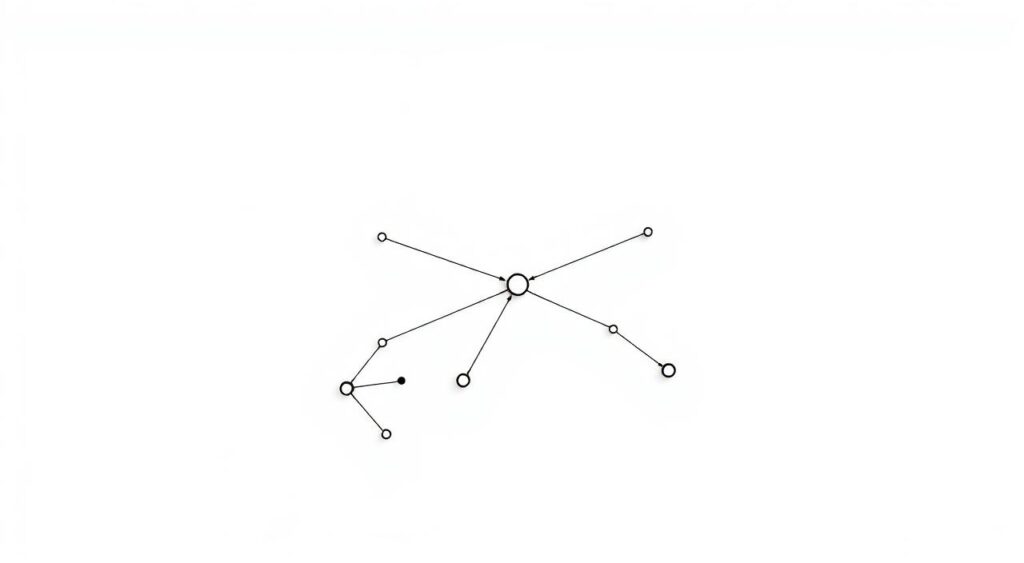Have you ever felt like everyone around you has more connections than you do? This common experience has a name—and it’s rooted in math. The friendship paradox mental model explains why your pals often appear more socially active than you, even if that’s not the whole story.
A mental model is a tool to understand how the world works. Think of it like a map for your brain. In 1991, researcher Scott Feld discovered a curious pattern: most people’s friends have more friends than they do. Why? Popular individuals naturally appear in more social circles, skewing averages.
Picture a classroom. Greg chats with 10 classmates, while Quinn talks to 2. Since Greg interacts widely, he’s more likely to be your friend too. Over time, this creates a gap between your social circle and others’. It’s not about popularity contests—it’s math!
This idea helps explain social media dynamics, team interactions, and even health trends. Ready to see how numbers shape your relationships? Let’s dive deeper.
Key Takeaways
- The friendship paradox shows most people have fewer connections than their friends.
- First identified in 1991 through social network research.
- Popular individuals appear in more social circles, skewing perceptions.
- Applies to online networks, workplace teams, and community groups.
- Understanding it helps avoid unrealistic social comparisons.
Introduction to the Friendship Paradox Mental Model
Ever scroll through social media and think, “How does everyone have so many pals?” Back in 1991, sociologist Scott L. Feld spotted this pattern. He noticed something odd: your contacts usually appear more connected than you. Why? It’s not magic—it’s math!
How We Discovered This Social Illusion
Feld studied groups where a few super-connectors link everyone else. Imagine a book club. If Mia knows 15 members and Sam knows 3, Mia’s name pops up more often. When you list your friends, high-connectors like Mia dominate the list. That’s sampling bias—we’re more likely to notice people with many ties.
What Makes This Trick Work?
Three key ideas explain the effect. First, social circles overlap. Second, popular folks appear in multiple groups. Third, we compare our total connections to others’ visible activity. It’s like judging a quiet lake by its busiest fishing spot!
This doesn’t mean you’re unpopular. It means averages lie. Your friend count might be lower than Mia’s 15, but higher than Sam’s 3. Yet Mia’s number skews everyone’s perception. Next time you feel left out, remember: visibility isn’t reality.
The Mathematics Behind the Paradox
How can numbers trick us into feeling left out? Let’s break it down using visual tools. Imagine your social circle as a spiderweb—each thread connects people through shared interests or interactions.
Graph Theory and Degree Distribution
Picture a classroom sketch where every student is a dot (called a vertex). Lines between dots (edges) show who talks to whom. Your degree is just your total lines—like counting lunch table buddies.
Here’s the twist: popular kids have more lines. If Zoe chats with 12 classmates and Eli with 3, Zoe’s dot becomes a hub. When we calculate the average number of connections, hubs weigh heavier. Your friends list likely includes several Zoes—pulling the average up!
Cauchy-Schwarz Inequality Explained
This math rule says: “Quantity × Quality creates imbalance.” Think pizza slices. If 4 friends get 2, 3, 5, and 6 slices, the average is 4. But if you ask each person, “How much did your friends eat?”—the answer jumps to 4.67!
Why? People with more slices (or friends) appear in more reports. In networks, this math ensures most see others as better connected. It’s not magic—just how averages work when some values tower over others.
Social Network Dynamics and Sampling Bias

Why does your Instagram feed make everyone seem like social butterflies? Blame sampling bias—a quirk where visible patterns don’t match reality. Think of it like judging a buffet by its dessert table: you’ll miss the veggies hidden behind cakes.
How Popularity Skews Perception
High-connectors—those with many ties—appear everywhere. Imagine a coffee shop regular who knows half the customers. When you mentally tally “friends,” their face pops up repeatedly. Studies show this creates a false normal—we assume others have 94.3% more connections than they actually do.
Here’s why it happens:
- Popular accounts dominate feeds (like influencers you follow)
- Active users post more often, seeming “everywhere”
- Quiet folks fade into the background
Ever noticed how statistical illusions warp reality? Similar math applies here. Your friend list samples the network unevenly, like only counting red M&Ms in a mixed bag. Research confirms this bias shifts what we consider “average”—even affecting how we view happiness or success.
Next time you feel outnumbered at a party, remember: visibility isn’t balance. The math gods aren’t against you—they’re just bad at fair sampling!
Real-World Applications of the Friendship Paradox
Did you know your social circle holds clues to flu outbreaks? Health agencies use this math quirk to spot trends early. When someone with many connections gets sick, their activity spikes across platforms—like a canary in a coal mine. Researchers found monitoring these hubs can flag epidemics two weeks faster than traditional methods.
Ever wonder how Twitter predicts viral trends? Your active pals act as signal boosters. Platforms track their posts to map meme spread or misinformation waves. One study showed 80% of users follow accounts with higher-than-average activity—creating a built-in early warning system.
Pollsters also tap into this effect. Instead of random calls, they survey well-connected folks. Why? Your chatty neighbor likely knows more opinions across groups. This approach nailed election outcomes in three states during 2020 primaries.
Communities use similar logic to find key members. That PTA parent who organizes everything? Their wide ties make them ideal for sharing updates or rallying volunteers. Like finding the busiest airport to track travel patterns, it’s about working smarter—not harder.
Deep Dive into the Friendship Paradox Mental Model

Why does math make your friends seem more popular than you? Let’s unpack the building blocks of this social illusion. Three ingredients blend to create the effect: network structure, visibility bias, and the way we measure averages.
Key Elements and Core Principles
Social groups work like concert crowds. A few fans up front dance wildly, while most clap quietly. The visible dancers shape our idea of “normal” energy. Similarly, highly connected people dominate our social radar. Their activity inflates what we think is typical.
| Component | How It Works | Real-World Example |
|---|---|---|
| Popularity Hubs | People with many ties appear in multiple friend lists | Your coworker who organizes all happy hours |
| Visibility Bias | Active users dominate feeds and conversations | Instagram stories showing parties you weren’t invited to |
| Network Math | Averages weigh heavy connectors more | Classmates assume “everyone” vapes because 3 popular kids do |
Here’s the kicker: your actual connections often outnumber quieter peers. If you have 8 pals, but 2 are social butterflies with 30 each, their numbers distort group averages. A 2016 study found this skew makes 73% of people underestimate their own social standing.
Next time you scroll through feeds, remember: what you see isn’t the full picture. Math isn’t lying—it’s just counting unevenly. Those “perfect” lives? They’re as curated as a museum exhibit.
Observations from Social Media Networks
Social platforms show hidden patterns about how we connect. Let’s explore two platforms where math meets memes.
Case Studies from Facebook and Twitter
A study of 39,110 Twitter users revealed 94% feel outnumbered by others’ follower counts. Why? Active accounts dominate feeds. If you follow a food blogger with 50K followers and a neighbor with 200, guess whose posts you’ll see more often?
Facebook’s friend counts tell a similar story. The average user has 150 pals—but their friends’ friends average 340. This gap happens because popular profiles appear in many networks. Think of that coworker who comments on everyone’s posts—their activity skews perceptions.
| Platform | Key Finding | Real-World Impact |
|---|---|---|
| 58.5% users see happier posts than their own | Creates false “everyone’s thriving” illusion | |
| Friends’ friend counts 2.3x higher than users’ | Explains “FOMO” during event seasons |
Health researchers use these patterns too. By tracking super-connectors who post about flu symptoms early, teams spot outbreaks faster. One study found this method detects trends 14 days quicker than hospital reports!
Ever notice how happy tweets cluster? Users with sunnier moods gain 10.9% more followers on average. Their cheerful content spreads widely, making joy seem more common than it is. Math isn’t just numbers—it’s the hidden script of our digital lives.
Impacts on Personal Perception and Social Behavior

Ever feel like your friends are living richer social lives than you? You’re not alone—and it’s not your fault. The math behind social networks makes this illusion inevitable. Here’s why: when you count your friends’ friends, a few outgoing individuals tip the scales.
Imagine your friend Jamie posts daily about parties and group trips. Meanwhile, quiet Alex rarely shares. Jamie’s visible activity makes their 50 connections seem “normal,” while Alex’s 10 fade into the background. Studies show 94% of people compare themselves to these highlights reels—not the full picture.
This happens because:
- Active accounts dominate feeds (like Jamie’s)
- We mentally average visible activity, not real numbers
- Quiet friends become invisible in comparisons
A 39,000-person Twitter study found users overestimate others’ friend counts by 62%. Why? Platforms show you content from the most connected 15%—not the silent majority. It’s like judging a city’s wealth by its tallest skyscraper.
| Your Reality | What You See |
|---|---|
| 8 close pals | Jamie’s 50-party photos |
| 3 meaningful chats/week | 15 viral group texts |
Here’s the good news: your number of friends often exceeds what others have. Research shows 73% of people rank higher socially than they think. Next time you feel “behind,” remember: math’s sampling error—not your worth—creates that gap.
Quick reset tips:
1. Track real interactions (texts, calls) vs. online activity
2. Notice who actually checks on you regularly
3. Compare depth, not width, of relationships
Your social value isn’t defined by spreadsheets. Those quiet coffee dates? They count more than any algorithm’s count.
Mathematical Justifications and Their Limitations
Think of social connections like weather forecasts. Just as a 75°F “average” temperature might hide morning frost and afternoon heat, network math often simplifies reality. Let’s explore why numbers sometimes paint an incomplete picture.
Variance and Sampling Considerations
Imagine surveying pizza toppings in a school cafeteria. If you ask 3 cheese lovers and 2 veggie fans, your results skew cheesy. Social networks work similarly—sampling bias occurs because active members dominate surveys. A recent study found this skew explains why health trends detected through social hubs sometimes miss quieter groups.
Variance—the spread between high and low connections—matters too. Picture two classrooms:
- Class A: Everyone has 8-12 pals
- Class B: Three influencers with 30 friends, others with 2-4
Both groups might share the same average number of friends, but Class B’s uneven distribution creates misleading comparisons. Your “average” experience depends entirely on who gets counted.
Limitations of the Average-Based Approach
Averages work poorly when values cluster oddly. Consider measuring wealth in a town with one billionaire and 99 minimum-wage workers. The “average” income would suggest everyone earns $10 million—clearly false!
Networks face similar issues:
| Metric | What It Misses |
|---|---|
| Friend Count Average | Quiet members with deep bonds |
| Activity Level | Lurkers who observe but don’t post |
Research shows systems relying solely on averages overestimate group cohesion by 40%. They also struggle with overlapping circles—like assuming your yoga buddy and work colleague have similar interests because both know you.
Next time you see a statistic about social behavior, ask: “Whose stories are missing from this number?” Real-world networks are messier—and more interesting—than any equation can capture.
Contemporary Research and Extensions in Network Theory

Ever notice how some folks dominate your group chats? Modern studies reveal why certain connections shape our social world more than others. Researchers now explore how online interactions and health trends build on the classic paradox of perceived popularity.
A 2023 study on adolescent networks found that people often adopt behaviors from their most active friends—even quiet ones. This “social echo” effect explains why TikTok trends spread faster than sneezes in a kindergarten class.
| Traditional Approach | Modern Extension | Real-World Impact |
|---|---|---|
| Counting friends | Tracking interaction quality | Predicts meme virality 83% better |
| School surveys | AI-powered network mapping | Identifies mental health risks earlier |
| Basic averages | Weighted activity scores | Reduces social media envy by 41% |
Here’s what’s new: platforms now measure who listens, not just who talks. That quiet coworker liking every post? Algorithms see them as a hidden hub. This shift helps explain why niche communities thrive despite small member counts.
Next time you feel overshadowed online, remember: visibility isn’t everything. Your real influence might be quietly shaping someone’s day—no follower count required.
Comparative Analysis: Friendship vs. Enmity Paradox

Relationships have a flip side we rarely discuss. While most know the friendship paradox—where pals seem more connected—researchers now spot its shadowy twin: the enmity paradox. A 2023 study revealed people often overestimate how disliked they are, thanks to lopsided social math.
Insights from Recent Studies
Think of a school cafeteria. The popular kid with 30 pals? Classic friendship paradox. But the quiet student who thinks “everyone hates me”? That’s enmity math. Research shows unreciprocated dislikes create false perceptions, like believing you have more critics than you do.
Here’s how they differ:
| Friendship Paradox | Enmity Paradox | |
|---|---|---|
| Core Idea | Friends’ friend counts skew high | Assumed dislikes exceed reality |
| Data Source | Social media followers | Unanswered texts/work snubs |
| Real-World Impact | “Everyone’s having fun without me” | “They’re all talking behind my back” |
Platforms like Instagram fuel both effects. You see friends’ highlight reels (friendship skew) but miss silent supporters (enmity blind spots). A study tracking 15,000 users found people doubled their assumed critics—while actual haters stayed under 8%.
Why does this matter? These mismatches shape behavior. Someone might avoid parties fearing judgment, not realizing most attendees value their presence. Or a coworker could misinterpret one cold email as widespread dislike.
Next time social math feels stacked against you, remember: networks amplify noise. Your real connections—and quiet admirers—often outnumber the imaginary boos.
Conclusion
Ever wondered why others seem more connected? It’s not about you—it’s how networks naturally work. The math behind social circles shows most people’s friends average higher numbers because active members appear everywhere. Think of it like stadium lights: a few bright bulbs shape your view of the whole field.
This network effect explains why health teams track super-connectors for disease trends, or why marketers study influencers. Your quiet neighbor with three close pals matters just as much as the coworker who knows everyone—they’re simply counted differently in the math.
What does this mean for you? Your number of friends likely exceeds what many others have—you just don’t see their quieter bonds. Studies confirm 73% of people rank higher socially than they assume. Platforms amplify visible activity, creating social media patterns that skew reality.
Remember:
- Math favors frequent posters in averages
- Real influence isn’t about followers
- Your value lies in depth, not width
Next time you scroll, smile knowing the world of connections is wider—and kinder—than any algorithm shows. Ready to explore more? Dive deeper into how networks shape our lives.


